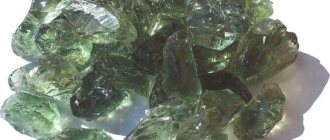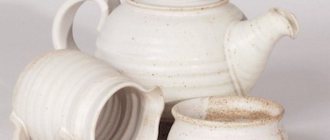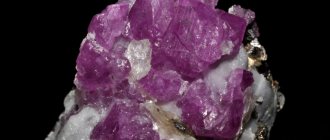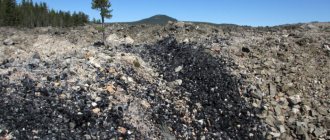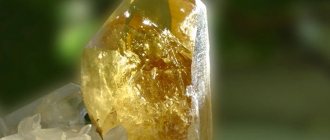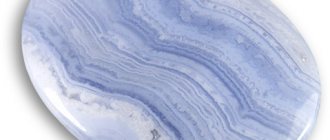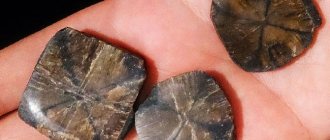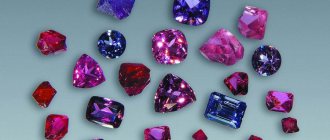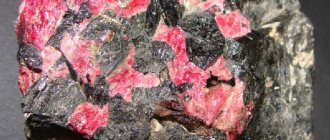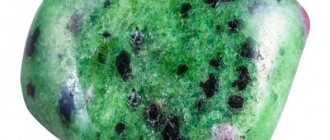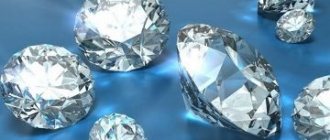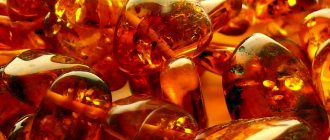“Mute diamonds often have a stronger effect on a woman’s mind than any eloquence,” said the great Shakespeare. Since ancient times, people have learned to create a jewel that sparkles in the rays of light - a diamond - from an inconspicuous-looking diamond. Cutting a gem diamond is a difficult task. The master analyzes the size, proportions, and characteristic shape of the crystal and decides how many facets the diamond will have.
Where is the best place to choose diamonds?
As a rule, it is recommended to purchase precious stones in jewelry stores. This way, you can assess the quality of the stone in a relaxed atmosphere, and, if necessary, look at the gemological certificate, which contains data on weight, clarity, type of cut and other parameters. In addition, if you suddenly have complaints about the quality of a gemstone, you can contact the salon and sort out the problem.
Some people choose stones from specialized online stores or at auctions. But, before making any online purchase, read reviews about a particular online site and thoroughly study the history of the company.
How to choose a diamond according to characteristics
Diamonds are used to set rings, bracelets, pendants and other jewelry. You can also purchase a gemstone separately, for example, to set it in a piece of jewelry made to order.
If you don't know how to choose diamonds when purchasing, a diamond certificate can help you. It is issued for all diamonds of natural origin and weighing from 0.29 carats. A document confirming the authenticity of stones is issued, for example, by the Gemological Center of Moscow State University and the Russian Gemological Laboratory, as well as various international organizations such as GIA, HRD Antwerp. The certificate contains:
· information about the manufacturer;
· Name of product;
date of manufacture, dimensions of the stone;
· type and grade of frame material;
· type and quality of cut.
Before choosing diamonds, read the certificate. Also consider a number of other characteristics.
Carat
The weight of diamonds is measured in carats (ct). One carat is equal to 0.2 g. This is how much one carob seed, which grows in the Middle East and the Mediterranean, weighs. Diamonds are divided into three types based on carat content:
· small - 0.29 ct or less;
medium - from 0.3 ct;
· large - from 0.7 ct.
As a rule, jewelers encrust rings and rings with large diamonds, while smaller options are chosen for earrings, brooches and other jewelry.
It is worth understanding that the weight of a gemstone does not always correlate with its size, but the price of stones of different categories can vary greatly. Thus, stones weighing 0.99 carats visually look the same as one-carat diamonds, but are slightly cheaper than the latter.
Place of Birth
Rough Diamond
Industrial diamond deposits are scattered throughout the planet, with the only exception being Antarctica.
In percentage terms, the production volume was distributed as follows:
- First place - Russian, which also develops mines in Botswana, Zimbabwe and Angola - 28%.
- The second is the South African corporation De Beers, which produces in Tanzania, Namibia, South Africa and Botswana - 20%.
- Third – Australian-British miner Rio Tinto – 13%.
- Fourth – Canadian company Dominion Diamond – 6%.
- Fifth – South African company Petra Diamonds – 3%.
- The remaining 30% of production comes from all other diamond miners.
The very first deposits are the mines of India, which by the end of the 20th century were practically depleted. In 1727, the richest deposits of diamonds were discovered in Brazil, in 1867 - in South Africa.
This is interesting!
In Russia, the first diamond was discovered in July 1829. This event took place in the Perm Province (Ural) at the Krestovozdvizhensky gold mine. A stone weighing half a carat was found by 14-year-old serf Pavel Popov, for which he received his freedom. A little later, the teenager brought members of Baron Humboldt’s expedition to the same place, who discovered several more small pebbles. At the moment, the treasured place is called “The Diamond Key”. Today, the richest Russian deposits are located in Yakutia. At the end of 2019, it was there that the first Matryoshka diamond in the history of world mining was found - a gem within which another smaller pebble moves freely.
Cut
Its brightness and appearance depend on the quality of stone processing. The type of cut and the accuracy of the angles determine the brilliance and beauty of a diamond. The quality of the cut is assessed on a letter scale:
· A - higher;
· B - good;
· B - average;
· G - low.
If you decide to choose a diamond ring or earrings, an important characteristic will be the cut shape. The classic version is considered to be a round cut with 57 facets. Stones cut in the shape of a heart, drop, square, rectangle or oval look original.
Types of processing
There are several forms of cutting. Popular among jewelers are:
- “Princess” - 65 falsettos;
- “Heart” - 57 falsettos;
- "Oval" - 57 falsettos;
- “Marquis” - 55 falsettos;
- “Pear” - 56 falsettos;
- “Triangle” - 52 falsettos;
- “Square” or “Rectangle” - 17 or 33 falsettos.
Such work is not considered classical by masters, but it can be carried out depending on the requirements of the company, the jeweler, the buyer or the shape of the diamond.
During the Soviet Union, another form of mineral processing was developed, which was called “Russian Diamond,” but it did not differ in anything special from those already existing. Therefore, the concept did not take root. But today this term is used to evaluate minerals that have a specific hue.
Diamonds
The quality of a jeweler's work is determined by a scale. The highest work receives an “A” grade, then the quality of the master’s work is determined in descending order.
There is also a method of cutting diamonds, which is called “Baguette”, and is used for processing small-sized minerals. Moreover, the girdle of such stones has the shape of a rectangle or square.
The baguette cut stone has 25 and 33 facets. Diamond processing and such a concept as quality of work are considered a subjective evaluation criterion. A smaller mineral that does not have the classic 57 falsettos can also be beautiful.
Another interesting fact is that diamonds that have the shape of a triangle are called “trilliant” by jewelers. They are especially beautiful due to the refraction of the sun's color inside the mineral.
Other minerals can be processed in a characteristic way:
- White sapphire.
- cubic zirconia
- Quartz (crystal).
- Zircon.
- Pomegranate.
They are similar in color to diamonds, so this type of treatment is suitable for these stones. They also have a crown, pavilion and rudist, characteristic features of a goldsmith's work.
How are diamonds processed?
Diamond cutting is complicated by the hardness of the mineral - 10 out of 10 on the Mohs scale. For each stage of production, certain devices are used.
- Diamond cutting is carried out using a laser or diamond saw, the rotation speed of which reaches 9000 revolutions per minute.
- Peeling is done with a diamond cutter; this is rough processing, during which contours and future edges are outlined. This produces diamond dust, which is used in the production of diamonds.
- Cast iron discs are used for grinding, which barely touch the crystal when rotating. First, the upper and then the lower facets (beveled side edges) are polished.
- Polishing is carried out using a horizontally positioned iron polishing wheel. From time to time, the product is washed with water to remove waste and shavings.
- The final stage is boiling in sulfuric acid. This cleans the diamond of dirt, oil, and diamond powder.
Color
Colorless stones
Transparent stones are considered the most valuable. Colorless diamonds are divided into nine groups. The first group includes absolutely transparent stones, and the ninth group includes brownish or visible yellowish stones. Stones of groups 3–5 are considered popular. There is also a letter-based international classification, in which the color of stones is distributed from D to Z.
It is impossible to visually notice the difference between the stones of the third and fourth, as well as the fourth and fifth groups. At the same time, the difference in price is quite noticeable. Therefore, when the question is which diamond to choose, the decision depends on whether you are willing to overpay.
Colored stones
The cost of colored diamonds is affected by the brightness and saturation of the hue. Most often, colored options are cheaper than colorless ones, but there are exceptions. Thus, stones of the so-called fancy colors can be more expensive than the most transparent samples.
A little history
A diamond is not distinguished by its brilliance and in this parameter is significantly inferior to a diamond. It is not surprising that until stones were learned to be processed, they were not in great demand.
The situation changed radically when one of the court jewelers came up with the idea of working a little with the diamond. He subjected it to processing, the master created only a few faces and presented the result of the work to the king. This happened in the 16th century, since then diamonds have become rare and expensive, they began to be perceived as a symbol of power and prosperity.
Initially, they used a rose-shaped cut: jewelers created only a few facets by polishing the diamond a little. However, this was enough for the stone to begin to sparkle.
Today, this form of processing is considered obsolete, but crystals are still cut in this way, since “rose” has two significant advantages: it is easy to perform and allows you to minimize costs.
During processing, the mineral loses from 35 to 70% of its original mass. If the stone is rare and expensive, then a complex cut can significantly reduce its weight - for this reason, a jeweler may use a rose-shaped cut.
Despite the fact that diamonds began to be processed a long time ago, jewelers did not immediately achieve significant success in this matter.
In 1919, mathematician Marcel Tolkowsky was able to calculate the ideal proportions of diamonds. It is worth noting that back in the 17th century there was a cut similar to diamond or classic, but this method of processing crystals was far from ideal.
Thanks to the calculations of Marcel Tolkowsky, it was possible to create a cut in which light entered the stone through the crown, it was refracted from the faces that were located below. As a result, the light began to play with rays, a “rainbow” was created. This was the so-called ideal cut of 57 falsettos, which is still used today.
Today, there are several forms of diamond processing; the cutting method largely depends on the size of the stone and the presence of defects in its structure.
Purity
Before choosing jewelry or stones separately, consider not only the carat value, but also the clarity of the diamonds. The radiance of stones is determined by their ability to transmit light rays: the lower the purity index, the less pronounced their shine.
Absolutely pure stones without any inclusions are quite rare, which affects their cost. Such samples are often sold without frames, and they are subject to mandatory certification. To assess the clarity of diamonds, there is an international scale consisting of 11 levels: from IF - an absolutely pure stone, to I3 - a diamond with defects and inclusions.
The Russian classification provides:
· for small stones - 9 purity groups;
· for large ones - 12 purity groups.
Perfectly clear diamonds receive a 1, while those with noticeable and/or numerous inclusions receive a 12.
If your goal is to choose diamond jewelry for beauty and not for investment, take a closer look at diamonds that belong to groups 3–4 in color and 1–7 in clarity. As a rule, it is better not to purchase stones of levels 9–12 - due to numerous defects, they often split and do not look very attractive.
The magical properties of diamonds
Diamond
Diamond is a majestic stone - the jewel of the powerful. It symbolizes determination, fearlessness, willpower, power, but also generosity and nobility. Contrary to beliefs, its meaning has nothing to do with luxury and wealth. The main properties of the stone, valued since ancient times, are hardness and eternity, so it has always personified steadfastness of spirit and longevity.
The element of the stone is fire, so it distinguishes people who prefer to “burn” and achieve, rather than exist quietly and peacefully “as a carbon copy.” Diamond will help these people in everything, but only if their thoughts are pure and noble. It will strengthen all the positive qualities of the owner, and will begin to eradicate the negative ones, sometimes very painfully.
The magic of diamond has no clear direction; it affects “on all fronts”, making a person lucky, professional, leader, winner, happy lover, versatile and self-sufficient person.
How to choose diamond jewelry: criteria for determining quality
Each piece of jewelry is attached with a tag indicating its characteristics. The same applies to large expensive diamonds that are sold without a setting. Let's look at an example of how to read a tag. Let's say we see the following: 5 KR-57 0.7 2/2 B.
What does it mean:
· 5 - the total number of diamonds in the jewelry;
· KR - cut shape, in our case, round;
· 57 — number of faces;
· 0.7 - the weight of one stone or the total weight of all stones in the decoration;
· 2/2 – color and clarity of diamonds on a scale from 1 to 9;
· B—cut level.
What to remember when buying a diamond
A professional gemologist or jeweler will help you choose the right jewelry. But since it is not always possible to take a knowledgeable person with you, it is advisable to remember several points:
· Decide on your purchasing budget. Consider how much you are willing to spend on a piece of jewelry or gemstone.
· Select several options, compare them with each other based on their main characteristics.
· Choose the product that best suits your price and quality.
· When purchasing a diamond, pay attention to the certificate - it must contain a detailed description of the stone’s parameters.
Experts recommend choosing jewelry with stones that have average gemological indicators - in the range from 3 to 5 (on a scale of purity, color). Such diamonds look decent in jewelry, and their cost is not prohibitively high.
How to distinguish natural stone from synthetic
Artificially grown diamonds are similar in physical and optical characteristics to natural ones. They are almost completely identical, except that synthetic stones are created in laboratory conditions.
Experts will help you accurately determine the origin of a gemstone. It is also quite possible to independently verify the authenticity of a diamond: for this you will need an ultraviolet lamp. Under the influence of ultraviolet light, natural stones glow with a light blue hue. Synthetic counterparts will typically have a yellow or green cast.
How to choose the right diamond ring
When purchasing a diamond ring, consider the size of the piece as well as the shape of your hands and fingers. So, for those with large palms and long fingers, rings and washer rings with large stones are suitable. On petite hands with thin fingers, round and flat rings with several small diamonds will look good.
Focus on your own taste and financial capabilities. If you are purchasing jewelry as a gift, ask about the wishes of the person you plan to give it to.
To choose the right diamond ring, consider a number of characteristics:
· Type of cut. A classic round cut would be a universal option, but jewelry with inserts of other shapes looks no less impressive: “Marquis”, “Heart”, “Princess”, “Drop”, etc.
· Frame material. Platinum, white or yellow gold are usually chosen as the setting for a diamond.
· Weight of decoration. It is good when the product into which the stone is inserted does not look too fragile. Thus, diamonds look quite harmonious in jewelry weighing at least two grams.
· Condition of inserts. Inspect the stones in the ring with a magnifying glass - there should be no scratches, chips or other visible defects on the inserts.
An equally important parameter when choosing is the type of stone fastening. The way the diamond is set determines the design and appearance of the ring. In addition, it depends on how securely the gemstone is fixed in the jewelry.
There are several options for setting diamonds:
· deaf, partially deaf;
· speckled, fadenovaya;
· corner, pavé;
· carmesine, teak;
· invisible.
Buy rings only from jewelry stores that have a reliable reputation in the market. When choosing products with large diamonds, study the certificate of authenticity of the stones.
Authentication
Sometimes the question arises about how to check a diamond for authenticity. After all, its high cost is an excellent reason for creating fakes and various imitations passed off as a real crystal. You can do this with the help of a specialist or yourself, at home.
How to determine the authenticity of a diamond:
- According to rudinist - a narrow boundary dividing a faceted crystal into upper and lower parts. It should be matte. Transparency indicates artificial origin.
- Hardness. Real diamond leaves marks on glass surfaces. It also scratches other minerals such as sapphires and rubies. The only exception to this method is moissanite, which has a hardness similar to diamond.
- Glitter and refraction of light. A real diamond sparkles, but not as much as moissanite. A natural crystal differs from fiant and zircon in its light refractive index: if you place the stones on a printed text, for example, a page of a book, you will not be able to see the letters through the original.
- Defects and inclusions. They are present in real stones and are absent in fakes, but in no case are they cracks on the surface, scratches or chips. What is diamond clarity →
- Light scattering and ultraviolet. A beam of light directed through a fake will remain just as intense. A real diamond glows under ultraviolet light.
- Marker drawing. A line drawn with a felt-tip pen or marker on the surface of a gemstone will be clear and even, whereas on a fake it will be blurry.
- Exposure to acids. Submerged in an acidic solution, a real diamond will endure the test with dignity, emerging unharmed.
- Indelible. It is difficult to erase a real stone, so you will have to examine the edges of the stone that has raised doubts. If they are smoothed out and appear erased, it is a fake.
Diamond rightly deserves the title of a unique and irreplaceable stone in the industry. At different times it was used for various purposes, but only when it gained jewelry interest did it become truly expensive. Its cost depends on the processing method, shape and changeability of fashion, but demand always remains high and is unlikely to ever change.
Sources
- https://zolotoe-runo-sl.ru/dragocennye-kamni/57-granej.html
- https://Brilliant24.ru/standarts/idealnaya-ogranka
- https://stone-stream.ru/interesnoe/ogranennyj-almaz.html
- https://obninsk-torg.ru/tehniki/br-kr-57.html
- https://PulsKamnya.ru/dragotsennie/almazy-i-brillianty/neogranennye
- https://velestone.ru/ukrasheniya/neogranennyj-almaz/
- https://zen.yandex.ru/media/gemstones/rojdenie-ogranki-brillianta-5cb2ffe06749e800b419fdcb
- https://PulsKamnya.ru/dragotsennie/almazy-i-brillianty/vidy-ogranki
- https://kamen.expert/dragotsennye-kamni/almaz-neogranennyj
